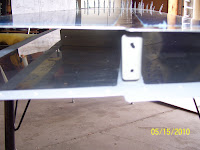
Ron Duren to the rescue (Again). He graciously accepted my invitation to drive to my house to buck 4 rivets to finish the repair work that took me most of the week to complete. He handled the bucking bar (left hand), while I drove the rivet gun (right hand). Notice the cool EAA T shirt that defines a pilot, and, yes, the wing parts still in the crates in the back ground - still working on that project.
And the finished task - 4 nicely set rivets, 2 on each side of the repair flange. Although standard aluminum patch practices may call for at least one more rivet on the spar-side of the repair, I stuck with 2 rivets on each side. The reasoning is that the skin is providing support with all the rivets that are attaching it to the spar and to the rib, so I think that there is adequate support in this area. I used an offset dome headed cup set for the rivets that attach the new flange to the spar web, which is about 5 inches longer than the normal cup set I would use for AN470 structural dome headed rivets. This allowed sufficient clearance of the rivet gun from the skins so that they would not get all banged up during the riveting process. Note that the repair was placed on the forward side of the spar web, and not the back, although when I marked the holes for the location of the rivets, I had it placed on the aft side of the spar web. This was because this was the only side that I could fit a straight drill bit (used a 12 inch extended number 30 drill bit to drill the holes.) Yes, I could have used my angle drill attachment to drill the holes from the other side, but I find this tool to be very inaccurate in terms of being able to drill a nice, straight hole, unless you can slap it in a vise to keep it from moving. So I opted to drill from the back side using a longer drill bit, and it worked out pretty well that way.

And from the other side - 2 more nicely set rivets, all in the original holes of the new rib that arrived from Van's "just in time." For some reason we had a little difficulty with the holes in the repair piece lining up with the holes in the rib after the piece was riveted to the
spar. This was strange to me because everthing had clecoed together perfectly before we started riveting. If I had one thing to do differently about this repair (hopefully I will not have to do this again but...) I would not match drill the holes in the rib to the repair piece until AFTER I riveted the part to the spar web. What I did this time was match drilled the rib holes to the repair piece after clecoeing the piece to the spar, but BEFORE it was riveted to the spar. If I would have waited until after I riveted the piece to the spar flange to drill the holes for the rib attach points, they would have lined up perfectly, which caused the mis-alignment of the holes on the other side. I can only guess that the act of riving the rivets to attach it to the spar pulled everything up tightLesson learned, but hopefully will not need to be repeated! Whew, that was a lot of work! But at least its done, and so is the HS riveting, for the most part. More on the finishing touches later.... Thanks again Ron for all the help.



















